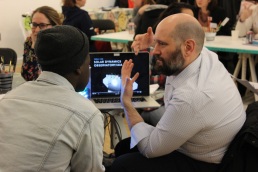Asides
MaryKay Severino
Co-Founder, Chief Operating Officer, Education Director
MaryKay is a native Bostonian who grew up in the Somerville/Arlington area. After graduating from Villanova with a Bachelor’s in Economics/Business, she went on to work in the business world, specifically in program management and marketing.
She then went on to earn her Master’s degree in Education and worked in public & private K-12 school systems and universities in Taiwan and South Korea. Upon returning to the Boston area MaryKay worked in the K-12 public school system before leaving to start her own small business as a REALTOR® while also functioning as the Project Manager for the Eclipse Soundscapes Project at the Center for Astrophysics | Harvard & Smithsonian.
Living abroad gave MaryKay a strong understanding of the challenges faced by anyone who communicates differently. For this reason, the Eclipse Soundscapes project was a natural fit. There she used her program management skills to promote, plan, and execute a project which will bring the amazement and wonder of an eclipse to a more inclusive demographic and also developed a deeper love for Science.
Having worked as both a businesswoman and an educator, MaryKay realized that her passion lies in both building businesses and promoting and supporting more inclusive education utilizing the principles of Universal Design. This led her to start ARISA Lab with friend and co-founder, Trae.
September 6, 2020
Dr. Henry "Trae" Winter III
Co-Founder, Chief Executive Officer, Chief Scientist
Trae is a solar astrophysicist who has worked on eight NASA missions observing the Sun. His primary research focus was understanding how energy is released in the Sun’s atmosphere, the corona, and in other stars. Trae spearheaded many efforts to engage the public in scientific discovery, including work with the Montana Space Grant Consortium, the Salish-Kootenai Flathead Lake Reservation, and the Boston Lyrical Opera.
To highlight the spectacular images being produced by the Solar Dynamics Observatory, Trae designed a series of video wall exhibits for the Cooper Hewitt, Smithsonian Design Museum, the Smithsonian National Air and Space Museum, North Carolina State University’s Hunt Library, the Harvard Art Museums’ Lightbox Gallery, and the Museum of Boulder. However, Trae quickly realized many people had no access to the exhibits he was helping create, the blind and visually impaired (BVI).
To make science accessible to everyone, Trae began the Eclipse Soundscapes Project that built a mobile application that would engage all users with the 2017 Total Solar Eclipse. Consultants, who were themselves blind, were included at every stage of the application’s design process. The application used images, spoken word descriptions, sound, and touch to make eclipse features accessible and engaging to everyone as they were occurring.
Based on the success of the Eclipse Soundscapes Project model, Trae and MaryKay Severino founded the ARISA Lab which could quickly assemble highly trained and diverse teams to invent the new technologies and techniques necessary to make scientific exploration effective, accessible, and engaging for everyone.
September 6, 2020
For over two decades, the National Center for Accessible Media (NCAM) has been a national leader in making digital media accessible for people with disabilities. The team in NCAM—with over 150 years of combined experience in accessibility—are pioneers, inventors, and problem-solvers, frequently anticipating and creating solutions for tomorrow’s technology challenges.
September 4, 2020
NASA’s STEAM Innovation Lab is a think tank with an emphasis on space science content applications. It brings together NASA scientists, engineers and educators to explore and develop new ideas related to infusion of educational technology into STEAM (Science, Technology, Engineering, Art, and Mathematics) activities, programs and approaches. Inside the lab are 10 interchangeable STEAM exploration stations fitted with technologies typically found in many of today’s 21st century educational environments. By placing these stations in close proximity to each other, we encourage users to investigate how the technologies can be effectively blended together for greater impact and integration into NASA education programs and products.
September 4, 2020
The NASA Space Science Education Consortium (NSSEC) capitalizes on NASA’s rich history of sharing research and technology through compelling and innovative education projects. The NSSEC (formerly the Heliophysics Education Consortium (HEC)) continues the Science Mission Directorate’s (SMD) work at the forefront of NASA’s educational endeavors by linking exciting science and missions directly to the American public. The NSSEC team has learned from the strengths and weaknesses of previous programs and has a clear, adaptable plan forward.


September 4, 2020







